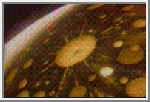Life from Mars: Video Animations
A NASA research team of scientists at the Johnson Space Center and at
Stanford University
has found evidence that strongly suggests primitive life may have
existed on Mars more than 3.6
billion years ago. Below are video and animation clips related to this
discovery.
 Cut 1
(MPEG, 980K)
Cut 1
(MPEG, 980K)
Between 3.6 billion and 4 billion years ago, when Mars was warmer and
wetter, water penetrated fractures in the subsurface rock. Saturated
with carbon dioxide from the Martian atmosphere, carbonate minerals
were deposited in the fractures. Living organisms also may have
assisted in the formation of the carbonate, and were fossilized. Then,
16 million years ago, a huge comet or asteroid struck Mars, ejecting a
piece of the rock. For millions of years, the rock floated through
space, falling in Antarctica 13,000 years ago as a meteorite.
 Cut 2
(MPEG, 1M)
Cut 2
(MPEG, 1M)
Scenes of meteorite ALH84001 being processed in the Lyndon B. Johnson Space
Center's Meteorite Processing Laboratory using a special glovebox and
airlock to prevent contamination.
 Cut 3
(MPEG, 933K)
Cut 3
(MPEG, 933K)
Planetary Scientists
Dr. David McKay, Dr. Everett Gibson and Dr. Kathie Thomas-Keprta study
slides of meteorite ALH84001 using a high-resolution scanning
electronic microsope at JSC.
 Cut 4
(MPEG, local 615K)
Cut 4
(MPEG, local 615K)
High-resolution scanning electron microscope images of possible
microscopic fossils, part of an array of indirect evidence found by NASA
research, appear to indicate primitive life may have existed on Mars
more than 3.6 billion years ago. The fossils were found in an ancient
meteorite, designated ALH04001, which is believed to be of Martian
origin.

 Mars
Mars
 Life
from Mars: The Discovery
Life
from Mars: The Discovery
 Cut 1
(MPEG, 980K)
Cut 1
(MPEG, 980K)
 Cut 2
(
Cut 2
( Cut 3
(
Cut 3
( Cut 4
(
Cut 4
(
 Mars
Mars